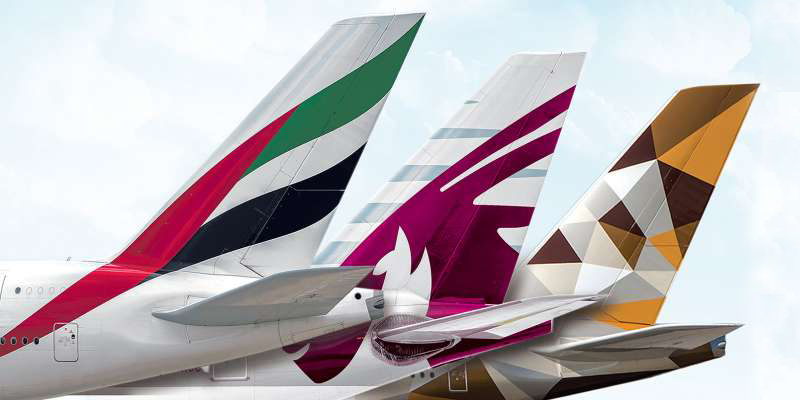There’s been plenty of talk about competition between Gulf airline carriers, let alone accusations from decrepit US carriers, envious of better business models, cost structures and operating efficiency.
Some recent price comparisons led us to a few interesting observations. We looked at return flights travelling on business class, departing December 1st, returning December 7th from Gulf’s largest hub, Dubai, to three of the world’s top destinations for business or pleasure, New York, London and Hong Kong.
The results are rather incredible, in fact this is what we’d call a price war.

Qatar Airways is 28% cheaper than Emirates, which is flying direct. Qatar Airways and Etihad entail a short transit via Doha and Abu Dhabi respectively.

Same again for London bound passengers, this time Qatar Airways is around 29% cheaper than Emirates.

Finally to Hong Kong, where Qatar Airways is a massive 41% cheaper than Emirates.
Sneaky Qatar
 It’s evident Qatar Airways has adopted a very aggressive discounting strategy on long-haul routes. We assume there are two, linked objectives.
It’s evident Qatar Airways has adopted a very aggressive discounting strategy on long-haul routes. We assume there are two, linked objectives.
- Build familiarity and a customer-base for the Qatar Airways brand and become a global preferred airline.
- Copy the “Dubai model” starting with the 1990s; essentially becoming a transit hub, then giving people good reasons to have extended stays and go after more of the visitor’s pocket (hotels, entertainment, shopping).
The second part is the ultimate objective, however it’s much harder to achieve unless one adopts the first part. Part 1 can be achieved through better service, clever marketing and lower prices. Seeing as both countries have relatively new airports, new fleets and well configured cabin seating, the easiest (laziest?) difference is compete outright on price. Hello Qatar Airways.
Challenging Environment
It’s no big secret that the regional leader, Emirates, has been finding the current climate challenging and have introduced a rafter of measures to generate additional revenues including for the first time ever, seat selection charges.
The airline said that fuel had been its biggest expense over the past year, at $5.4 billion and 26 percent of operating costs, while the strong US dollar had eroded its revenues by $1.6 billion, and its profits by $1.1 billion.
One wonders if they’ve been caught on the wrong side of fuel-hedging given prices are at recent history lows… but we digress.
Price Wars and Piggy-backs
There’s another angle to Qatar Airway’s strategy to steal market share from Emirates.

Of the 30+ flights a day from Doha to Dubai no less than 20 are operated by Qatar Airways. Flying that many flights into a major hub like Dubai reveals a leach piggy-back strategy. Qatar is looking to divert the huge volumes of passengers making stops in Dubai onto Qatar Airways connections. Over time, these customers will be tempted to stop over in Qatar, leave the airport and spend some dollars in the local economy. If Qatar manages to really get it right, they’ll become a tourist destination.
In the meantime they’re happy poaching passengers from Dubai’s busy hub, though also feed customers to Dubai, given Dubai has the infrastructure needed for tourism and the short term objective remains Part 1 (taking airline market share).
It would be interesting to know what the load factors are like on Qatar Airways operated Doha to Dubai flights versus the reverse.
The question to ask, is if Emirates is finding this environment tough, how on earth can Qatar Airways which has massively lower economies of scale compete when charging 30-40% less on some of the highest volume routes.
It’ll be interesting to see how long Qatar Airways keep this up and whether it will be enough make a dent in Emirate’s dominant position and whether it will lead them to their longer-term objective of becoming a destination.





Leave a Reply